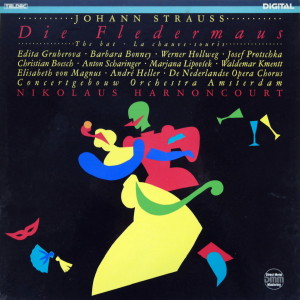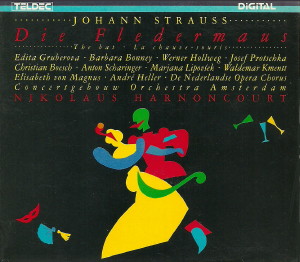 |
2 LP -
6.35762 EX - (p) 1988
|

|
| 2 CD -
8.35762 ZA - (p) 1988 |
|
Johann
Strauss (Sohn) (1825-1899)
|
|
|
|
|
|
|
|
Die Fledermaus
|
|
|
|
| Operette in drei Akten -
Libretto: Carl Haffner & Richard Genée
nach der Komödie "Le Réveillon" (Meillhac
& Halévy) |
|
|
|
|
|
|
|
| Ouverture |
|
9' 06" |
|
| I. Akt |
|
31' 25" |
|
| - Introduktion
(Adele, Alfred) |
4' 01" |
|
A1 |
| - (Frosch) |
0' 58" |
|
A2 |
| - Duettino (Rosalinde,
Adele) |
1' 08" |
|
A3 |
| - Terzett (Rosalinde,
Eisenstein, Blind) |
4' 34" |
|
A4 |
| - Duett (Eisenstein,
Falke) |
3' 54" |
|
A5 |
| - Terzett (Rosalinde,
Adele, Eisenstein) |
4' 23" |
|
B1 |
| - Finale I. (Rosalinde,
Alfred, Frank) |
12' 17" |
|
B2 |
II. Akt
|
|
42' 01" |
|
| - Chor und Ensemble (Chor
mit Soli) |
1' 49" |
|
B3 |
| - Couplet (Orlofsky) |
2' 57" |
|
B4 |
- Ensemble und Couplet (Adele,
Ida, Orlofsky, Chor mit Soli)
|
4' 38" |
|
B5 |
| - (Frosch) |
1' 05" |
|
B6 |
| - Duett (Rosalinde,
Eisenstein) |
5' 43" |
|
B7 |
- Csárdás (Rosalinde)
|
5' 31" |
|
C1 |
| - (Frosch) |
1' 04" |
|
C2 |
| - Finale II: Ensemble mit Chor (Rosalinde,
Adele, Ida, Orlofsky, Eisenstein, Frank,
Falke, Chor mit Soli) |
7' 45" |
|
C3 |
| - Finale II: Ballett (mit
Chor) |
6' 55" |
|
C4 |
| - Finale II: Ensemble mit Chor (Rosalinde, Adele,
Ida, Orlofsky, Eisenstein, Frank,
Falke, Chor mit Soli)
|
4' 34" |
|
C5 |
| III. Akt |
|
23' 20" |
|
| - Entreact |
1' 04" |
|
D1 |
| - (Frosch) |
1' 02" |
|
D2 |
| - Melodram (Frank) |
4' 35" |
|
D3 |
| - Couplet (Adele, Ida,
Frank) |
4' 51" |
|
D4 |
| - Terzett (Rosalinde,
Alfred, Eisenstein) |
8' 49" |
|
D5 |
| - Finale III (Rosalinde, Adele,
Ida, Orlofsky, Alfred, Eisenstein,
Frank, Falke, Chor mit Soli) |
2' 59" |
|
D6 |
|
|
|
|
| Josef Protscha,
Alfred
|
Anton
Scharinger, Dr. Falke |
|
Barbara Bonney,
Adele
|
Christian
Boesch, Frank |
|
| Edita Gruberova,
Rosalinde |
Marjana
Lipovśek, Prinz Orlofisky |
|
| Werner Hollweg,
Eisenstein |
Elisabeth
von Magnus, Ida |
|
| Waldemar Kmentt,
Dr. Blind |
André
Heller, Frosch |
|
|
|
| De Nederlandse
Opera Chorus / Johannes
Mikkelsen, Chorleitung |
|
| (Angela Bello,
Zong-Hee Kim, Ernst Theo Richter,
Jon Thorsteinsson, Jeremz Munro,
Andrea Poddiche, Solisten) |
|
| Concertgebouw
Orchestra, Amsterdam |
|
|
|
| Nikolaus
Harnoncourt, Leitung |
|
|
Luogo e data
di registrazione
|
| Concertgebouw, Großer Saal,
Amsterdam (Olanda) - giugno 1987 |
|
Registrazione
live / studio
|
| studio |
Producer / Engineer
|
Wolfgang Mohr / Michael
Bramman
|
Prima Edizione
CD
|
Teldec - 8.35762 ZA - (2 cd) -
56' 35" + 49' 16" - (p) 1988 - DDD
|
Prima
Edizione LP
|
Teldec - 6.35762 EX - (2 lp) -
56' 35" + 49' 16" - (p) 1988 - Digital
|
|
|
Back to
Johann Strauss
|
I cannot
remember a time when there was no
music in my lite. My father
used to play Johann
Strauss’ operettas and waltzes on the
piano as he had heard them time and
again as a young man, before the First
World War, in Vienna. He also played
Schubert and Beethoven, and as soon as
we children could play the cello or
violin adequately, we made music
together. But my father always played
Johann Strauss on his
own - I just listened. Thus this
music became part of everyday life tor
me, and when I later
came to play it myself in the
orchestra, I always
took it just as seriously as a Brahms
symphony or the St Metthew Passion. I
was fascinated by the natural ease
with which the Viennese - and only the
Viennese - played Johann
Strauss. In Vienna there
was of course an unbroken tradition
going back to the
original Strauss orchestra. Many
musicians from this legendary
orchestra, who had played under
Strauss himself,
passed on their knowledge. Their
pupils, some of whom are still alive,
played in the big Viennese orchestras.
There was also contact with the
composer’s widow Adele Strauss, who
did not die until 1930. Frau Strauss
was an expert and critical authority
on her husband's work,
and remained an energetic
representative of his intentions to
the end of her life. Notwithstanding,
one cannot ignore the fact that
certain small pauses have grown larger
from year to year, slow tempi have got
faster and fast ones slower, the dash
has become more dashing and the
innuendo too. The scores we used to
play from were in
every case the “arrangements” of
self-appointed Strauss "specialists”,
who claimed that the composer’s own
instrumentation really wasn’t that
good, and that Strauss himself hadn’t
stipulated exactly how the music
should be performed. The true reason
was of course quite different: when
the copyright restrictions were lifted
in 1931, thirty-two years after the
composer’s death, a real bonanza offered
itself to the clever arranger. Soon
enough, Johann Strauss
could be heard all over the world in
the most diverse arrangements, always
adulterated. Accurate, unedited scores
became almost unobtainable.
This situation has improved in recent
years. There are now a few good
editions of "Die
Fledermaus" on the market -
Swarowsky`s 1968
score, for example, or the Racek
edition published in 1974 by
the Johann Strauss Society - but in
general, it remains easier
to get hold of an original text
of Bach than of Johann
Strauss! And it is still the case that
Strauss' music is performed worldwide,
inexplicably even in his native
Vienna, in arrangements that to
differing extents distort the original
music. Thus, a number of "traditioirs”
have overlapped in the last sixty
years, and it is worthwhile
investigating the sources of the
various “typically Viennese” features
of Strauss interpretation. Among the
genuine Strauss there is quite a bit
of “forgery” that countless revered
Vienna performances have imbued with
an aura of authenticity.
Looking at the old scores, conducting
parts or other authentic sources, one
is struck by the fact that Strauss
expressly demands countless tempo
changes (eg. in the
slow part of the csárdás
no. 10: slow C, bar 9 () on the pause,
bar10 second half accelerando, bar 11
a tempo, bar 13 second half a ()
etc...), often within the shortest
space, e. g. the speeding-up or
slowing-down of half a
bar, then back to the previous tempo.
Many pieces are absolutely overloaded
with such markings. (In
the first part of the first finale, in
bar 197 - Du, du...
duidu, la la la - we
are normally offered a shower of
alternating fast and
slow tempt nowadays. This may well
have a fairly long tradition, though -
the indignant Adele Strauss
complained: "...I'd like to know who
was responsible for this...".)
If we compare recordings or
performances from the last 50
years, we find that for all their
diversity they do have one thing in
common: scarcely any attention is paid
to the composer’s instructions.
Instead, we hear numerous changes made
by individual interpreters, often very
clever and of considerable impact,
which have no foundation whatsoever in
the source material - they just
come from “tradition”. Not
unfortunately from a tradition that
goes back to Johann
Strauss, but one that was gradually
born from the interplay of effect,
arrangement, audience reaction and so
on. Here a couple of
examples from the overture: It
begins allegro vivace C, fairly fast
in other words; as soon as bar 7, a
resounding wrong note is heard from
practically every quarter - the flute,
both oboes and the clarinets,
and first and second violins should
play a D and not an E! In
bar 13, the allegretto is usually
played in a brisk alla
breve C today - but Strauss clearly
rubbed out this marking, and set the C
in 4/4, so this tempo cannot be
intended as fast. And in the tempo di
valse, the Fledermaus
waltz, a pause is made after
the fourth bar (bar 126),
growing longer and longer with the
passing of time, for which there is
absolutely no reason. On
the contrary, the hemiolas
(two disguised 3/2 bars
instead of the four 3/4 bars) in the
preceding bars (122-126) lead directlv
into the walz with the crescendo
molto. If Strauss had wanted such a
conspicuous effect, he would most
certainly have written it in. Even in
the text there is a whole series of
alterations which can
in no instance be seen as
improvements.
If we try to understand and then
realise the composer’s instructions,
we soon notice that there is no room
for extra “innuendos". Here,
even the above-mentioned good editions
are somewhat misleading, since, where
several good sources exist, they often
print the instructions from every one.
At some places in the score there is
thus an unnatural accumulation of
information: each individual score has
its own dynamics and tempo
relationships some of which loses its
point if one set of information
is copied overanother. However these
errors can easily be corrected: the
original, unarranged Strauss is
perfekt! The instrumentation
cannot be faulted -
unfortunately, we can no longer
realise it adequately, since
bombardons and F
trumpets for example are now a thing
of the past. The dynarnics and tempo
markings do not need any correction.
If anything, it is our listening
habits that should be changed, for it
is perhaps a little strange at first
to go without the charming Robert
Stolzisms and
rediscover the much more genuine, more
refined Straussian dialect.
Nikolaus
Harnoncourt
Translation: Clive R.
Williams
|
|
Nikolaus
Harnoncourt (1929-2016)
|

|

|
|